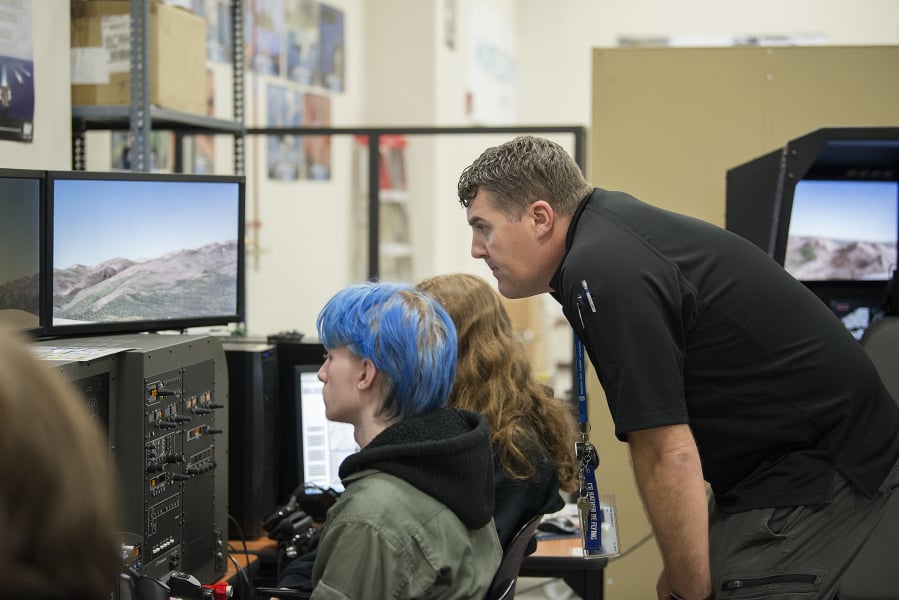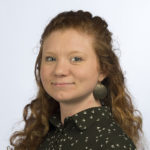Despite threats of automation, the world will need 790,000 pilots worldwide between now and 2037, according to Boeing’s Pilot Outlook report.
Working to prepare local youth for a spot in the cockpit — or other aviation-related job — is the job of former military pilot Robert V. Reinebach, an aviation technology instructor at Cascadia Technical Academy.
“One of the reasons they started the aviation program is because there’s a huge shortage projected,” said Reinebach, who also serves as a lieutenant colonel in the Oregon Air National Guard.
He spends his days with budding aviation workers from any of the 10 school districts that send students to Cascadia Tech. The academy offers career and technical training for interested juniors and seniors for the first part of their school day. Aviation is the newest program at the school, beginning in 2014, and this year has 92 students enrolled, according to Reinebach.
Cascadia Tech Academy
12200 NE 28th St., Vancouver
Employees: Two full-time teachers and one part-time to work with 92 students in the aviation program.
Funding: The school receives the money from the state that is allocated on a per student basis. Students attend for half the day so they get approximately half the funding that student is allocated from the state. Aviation is the newest program. Aviation gets a budget based on the students enrolled to pay for the teachers and equipment, maintenance and curriculum. Staff did not have current figures available.
Bureau of Labor Statistics job outlook: For career and technical education teachers, overall employment is projected to grow 4 percent from 2016 to 2026, slower than the average for all occupations. Demand for career and technical education teachers will be driven by a continued need for programs that prepare students for technical careers. The average salary in the Portland/Vancouver/Hillsboro area is $62,340. For airline and commercial pilots, employment is projected to grow 4 percent as well. “Most job opportunities will arise from the need to replace pilots who leave the workforce. Over the next 10 years, many pilots are expected to retire as they reach the required retirement age of 65,” according to the BLS. The average salary for a commercial pilot in the Portland/Vancouver/Hillsboro area is $65,210.
On a recent Thursday morning six students, separated into pairs, cozied into the fake cockpits of three flight simulators — or “sims” for short. Up to 12 can use the simulators at a time, while the rest of the students — there are 29 total, though several were absent that morning — worked on building model airplanes, an exercise that helps them understand the principles of flight. They’ll later fly the planes at a nearby stadium.
The students at the simulators were attempting to lift off and land in Telluride, Colo., at one of the highest-altitude airports in the United States.
“Just looking at this, do these mountains look like something you could make it over in your experience?” Reinebach asked the students, and several replied “No.”
“I like that you don’t like it,” he told them. “I want you to really notice on takeoff and flying, does this feel the same as when you take off out of Portland or Pearson? Or does it feel different? Just for today, I want you to try and work your way through.”
Students revved up their airplane engines, turning the dials and switches on the simulator accordingly.
Tiana Barnett, 18, and Mason Meek, 18, both seniors at Washougal High School, worked together on their simulator. Each took a turn being the main pilot while the other helped. They laughed and shrieked as they made maneuvers to clear the daunting computer-generated mountain range and attempt a landing.
“I think the biggest thing when I switched over here, they said whoever’s doing the work is doing the learning. So if I’m doing all the work, they’re not learning much. But if we set up scenarios where they can learn by doing they seem to learn a lot more. It’s challenging but you have to allow them to make mistakes that aren’t going to hurt them,” Reinebach explained of his approach to instruction.
Meek hopes to follow in his dad’s footsteps. He’s a pilot for SkyWest Airlines, which has headquarters in St. George, Utah. Meanwhile, Barnett plans to join the military — either the Air Force or the Navy; she hasn’t yet decided.
“It just seems like the best option for me after high school. My brother’s in the Navy right now and he loves it,” Barnett said. “I want to travel and get a good education.”
Reinebach joined the military for a similar reason, as a way to pay for school. He graduated from the U.S. Air Force Academy in Colorado Springs, Colo., in 2001. He said that his grandparents served in World War II but he never grew up having plans to be a pilot or join the military.
He happened to be in New York City in 2001 when he was working with an ROTC program for one year, awaiting pilot training after finishing school.
“The experience was significant, obviously,” he said, of the Sept. 11 tragedy. Then he was stationed at the Yokota Air Force base just outside of Tokyo for four years, and served in Iraq and Afghanistan, where he flew a reconnaissance airplane called the MC-12. He started instructing other Air Force pilots in Sacramento, Calif., teaching them how to fly the MC-12. Then he and his wife came to Clark County, where she is from originally. They wanted to be more tied to a community.
“I’d say most military pilots go fly for the airlines (after their commitment requirement of 10 years ends). That’s what all my friends did. That’s what I thought I would do too. It’s a really booming industry,” Reinebach said. “But for me … this was really desirable. To stay here, to sleep in my bed every night. I have a 10- and a 12-year-old, so I’ve gotten to see them grow up, coach rugby and do all those things.”
Back in the classroom, he focuses on teaching students ground school and prepare them for their Federal Aviation Administration knowledge test, then the hands-on school where they learn on the FAA-approved simulators.
“I try to teach them as if they were going through flight school, so when they do go through flight school they’re going to be like really prepared and ready to go,” he said.
The school tries to stay cutting edge with its technology, though the simulators are about 5 years old. He expects the software they use — X Plane 9 — will be upgraded in the next year or so.
WORKING IN CLARK COUNTY
Working in Clark County, a brief profile of interesting Clark County business owners or a worker in the public, private, or nonprofit sector. Send ideas to Hope Martinez:
hope.martinez@columbian.com; fax 360-735-4598; phone 360-735-4550.
Reinebach is optimistic about the future for pilots, despite some headlines.
“I think that you’ll see more and more airplanes having autonomous assistance. I’d say that if you ask any of our instructors here, or most pilots, I’m skeptical that a passenger plane will ever be fully autonomous,” Reinebach said. “I think you’ll always have two.”




